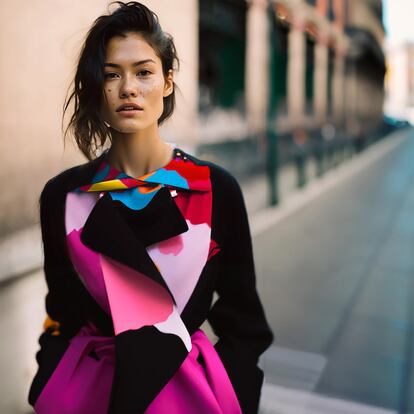Tilly Talbot, the controversial first artificial intelligence fashion designer
Australia’s Studio Snoop has incorporated an artificial intelligence collaborator into its daily routine, which works with the rest of the staff as another member of the team

This has been the year of artificial intelligence. And with it, great speculation and concern. Before stockpiling tins of food and locking ourselves in a bunker for fear that AI will rise up to exterminate humanity, let’s examine the current reality, which, for now, is kinder and offers us new applications in different fields.
Sydney-based Studio Snoop is the first design firm to integrate one into its daily routine: “Many of the things we see about artificial intelligence are worrying. The future is terrifying if we don’t commit to approaching AI with humanity,” says Snoop’s director, Amanda Talbot. Beyond the fear of job substitution, Talbot believes in a more collaborative vision: “I want to be optimistic and I also believe we need AI; that’s why I focus on how it can be collaborative and not a threat.”
The AI designer Tilly is part of the Snoop team and the rest of the firm interacts with her as one of them. This AI has the firm’s core values ingrained. “We’re still experimenting, figuring out what we can do,” says Talbot. “I think artificial intelligence has to be used to fight what we’ve already done wrong. I want it to understand that we are part of a whole, we are just another piece of the world.” Hence an approach far removed from anthropocentrism and focused on communion with nature.
AI is advancing in giant leaps but Tilly is still in a primary phase. The big challenge is the next step. Both the company and the AI are in the process of mutual learning: “We are now its main source of learning. It provides data or notes that we could not cover on our own. That doesn’t mean that we don’t check its input; we consult and work with it, but it is not our only source, far from it,” explains Talbot.
Being at an early stage of development does not mean that the application of AI to design is anything but extremely promising. Over the next five years according to analysis by McKinsey, a company that specializes in making industry predictions, it is estimated that artificial intelligence could contribute between $150 billion and as much as $275 billion in operating profits to the apparel, fashion, and luxury sectors. This figure, conservative in principle, demonstrates the significant potential of generative AI in these industries. From design collaboration to streamlining content development processes, generative AI opens up new possibilities for fostering creativity and innovation.
However, all of this has not come without controversy: the choice of a woman, her appearance, her youth, and the fact that her features are “archetypically beautiful” has raised some hackles. “We’ve done the best we could. This is all very new. I wanted it to have a human face and shape because it’s more relatable, it looks more real than if you’re just interacting with a screen,” Talbot says. During Milan Design Week, visitors had the opportunity to interact with Tilly, and that’s where some of these complaints originated. “I wanted her to be a woman because the design world has always been traditionally male and I was excited that the first female AI designer was a woman. Regarding her features, I was clear that I didn’t want her origin to be identifiable,” says Talbot.
Given this leap, one wonders what will come next: “At the moment we have London Design Week in September on the horizon and, if all goes well, Tilly will be doing her first collaboration with a renowned British designer,” says Talbot.
Sign up for our weekly newsletter to get more English-language news coverage from EL PAÍS USA Edition
Tu suscripción se está usando en otro dispositivo
¿Quieres añadir otro usuario a tu suscripción?
Si continúas leyendo en este dispositivo, no se podrá leer en el otro.
FlechaTu suscripción se está usando en otro dispositivo y solo puedes acceder a EL PAÍS desde un dispositivo a la vez.
Si quieres compartir tu cuenta, cambia tu suscripción a la modalidad Premium, así podrás añadir otro usuario. Cada uno accederá con su propia cuenta de email, lo que os permitirá personalizar vuestra experiencia en EL PAÍS.
¿Tienes una suscripción de empresa? Accede aquí para contratar más cuentas.
En el caso de no saber quién está usando tu cuenta, te recomendamos cambiar tu contraseña aquí.
Si decides continuar compartiendo tu cuenta, este mensaje se mostrará en tu dispositivo y en el de la otra persona que está usando tu cuenta de forma indefinida, afectando a tu experiencia de lectura. Puedes consultar aquí los términos y condiciones de la suscripción digital.










































